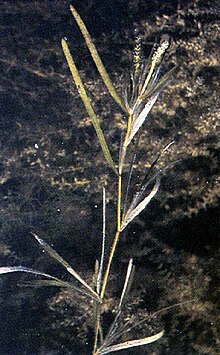Potamogeton compressus
| Potamogeton compressus | |
|---|---|
 |
|
| Scientific classification | |
| Kingdom: | Plantae |
| Clade: | Angiosperms |
| Clade: | Monocots |
| Order: | Alismatales |
| Family: | Potamogetonaceae |
| Genus: | Potamogeton |
| Species: | P. compressus |
| Binomial name | |
|
Potamogeton compressus L. |
|
| Synonyms | |
|
|
Potamogeton compressus is a species of aquatic plant known by the common names grass-wrack pondweed,flatstem pondweed and eel-grass pondweed.
Potamogeton compressus produces a strongly flattened, robust, branching stem up to 90 cm in maximum length . It grows annually from turions and seed, producing bushy plants branching near the surface with long, rather grass-like leaves that are 85–240 mm long and 3–6 mm wide and olive-green or dark green, sometimes with a reddish tinge near the surface. Each leaf has two veins either side of the midrib and is bluntly pointed. The leaves have a rather opaque appearance compared to the transparent leaves of most pondweeds, due of the presence of fibres called sclerenchymatous strands. There are no rhizomes or floating leaves.
The inflorescences are up to 6 mm long with 4-6 flowers with a short peduncle (5–20 mm long, occasionally more). The fruits are 3.1-4 x 2.1–3 mm.
Grass-wrack pondweed is relatively easily distinguished from most other pondweeds by its combination of strongly flattened stems and sclerenchymatous strands in the leaf . P. acutifolius is similar in Europe but can be distinguished by its sharply pointed leaves, less branched habit and flower spikes with only 2-6 flowers on peduncles up to 20 mm long. In the Far East, P. mandschuriensis is an altogether smaller plant, with leaves 1.5-2.3 mm wide and 8-14 sclerenchymatous strands, stem 0.8-1.5 mm wide, and fruit 2.8-3.8 mm diameter.
This is a diploid species, with 2n=28.
Hybrids with P. acutifolius (P. × bambergensis Fischer), P. oxyphyllus (P. × faurei Miki) and P. trichoides (P. × ripoides Baagøe) have been recorded. P. × bambergensis may be reasonably frequent where the two species coexist, but like many fine-leaved pondweed hybrids, is difficult to identify reliably without using genetic techniques.
Potamogeton compressus was first named by Linnaeus in Species Plantarum (1753). It should be noted that for much of the 19th century, Potamogeton friesii was incorrectly known as P. compressus, which has led to considerable confusion.
Grass-wrack pondweed is one of a group of rather closely related species that also includes P. acutifolius and P. mandschuriensis. North American populations have been assigned to Potamogeton zosteriformis Fernald. Although this is not a currently accepted name, there is molecular evidence to suggest it is probably distinct from P. compressus.
...
Wikipedia
